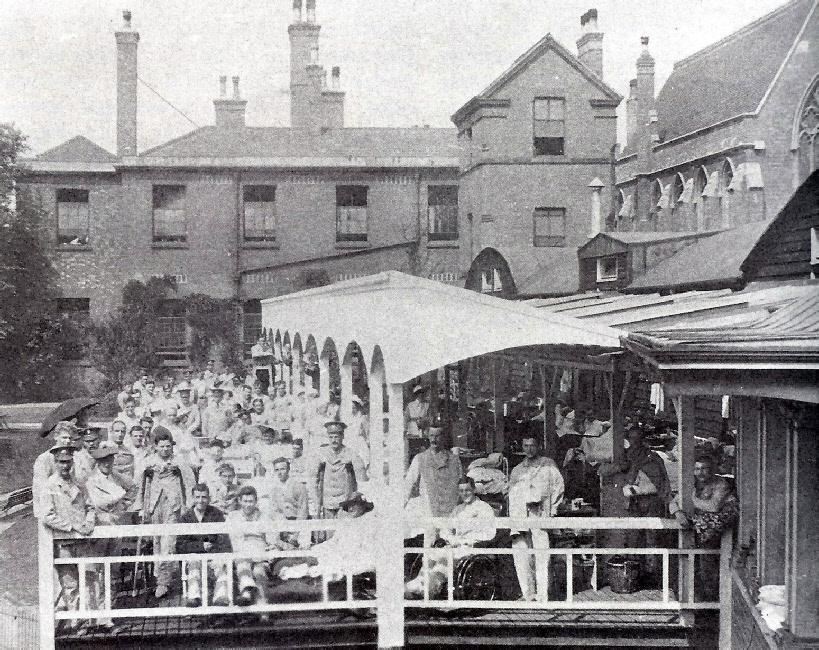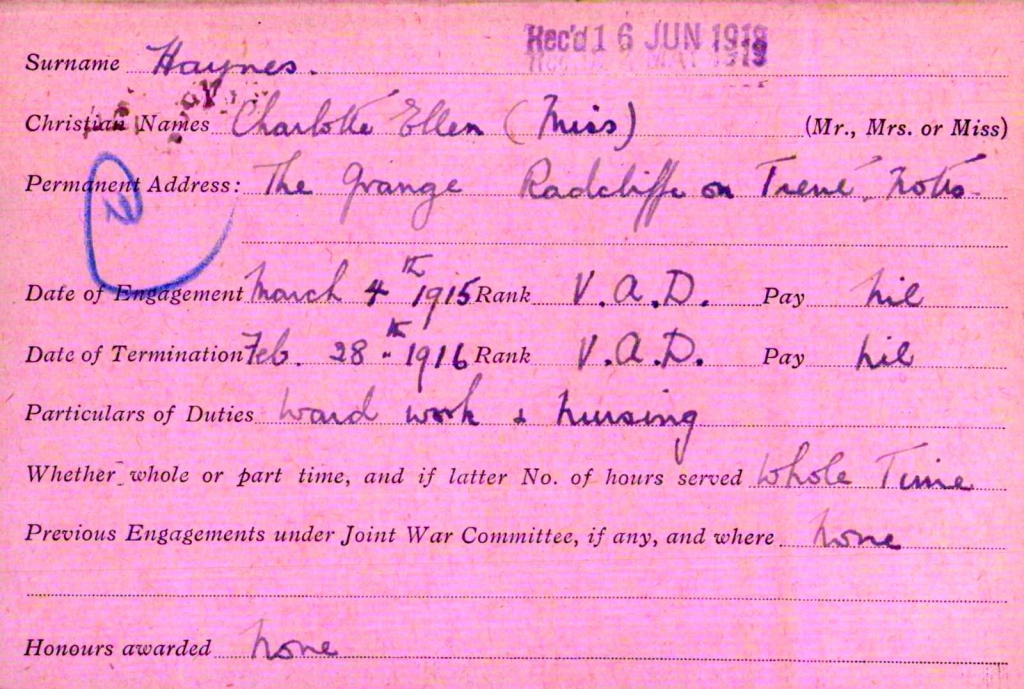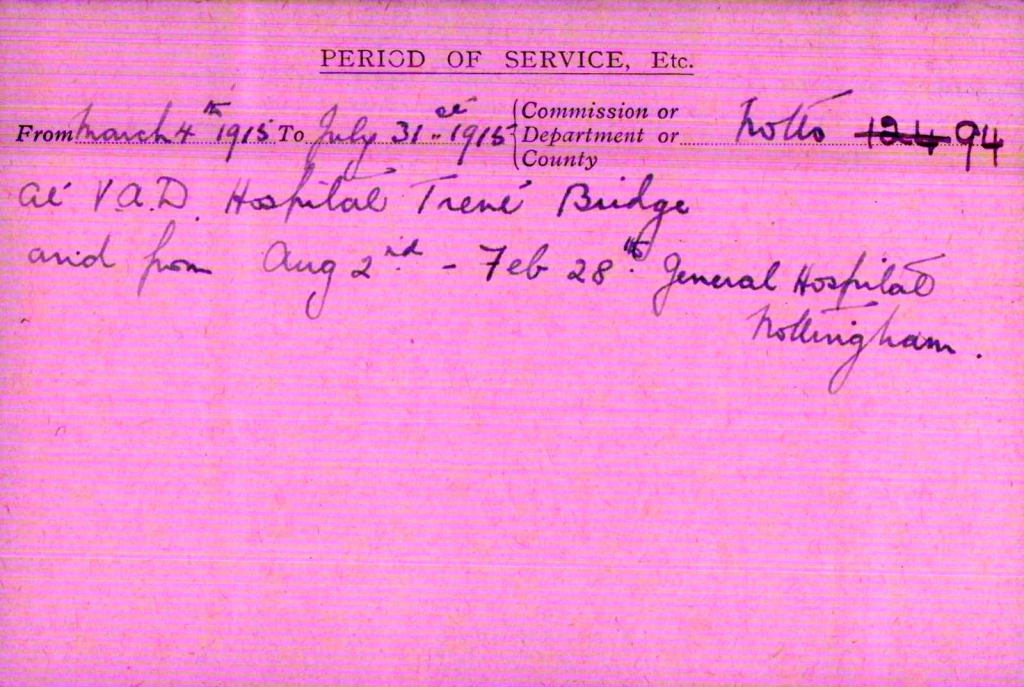CHARLOTTE ELLEN HAYNES 1890–1962

Wounded soldiers on the terrace at Nottingham General Hospital (photograph from http://www.nottinghamhospitalshistory.co.uk)
Born: 1890 in Radcliffe on Trent
Marriage: 21st July 1920 to William Eric Hands at St Mary’s Parish Church, Radcliffe on Trent
Children: Son John B. Hands born 1923 in Nottingham district
Died: 21st February 1962
Before the War
In 1891, 1 year old Charlotte was living on Main Road, Radcliffe on Trent with father Thomas, a maltster, mother Ellen (nee Boam) and brother William Brewster Haynes. They had a cook, Eliza Ward and a housemaid, Mary Raynor. Charlotte’s sister Emma, 5, was with her aunt and uncle Curtis in Nottingham. In 1901 the family were living in Royal Oak Yard, Main Road, Radcliffe. Father Thomas was a maltster (employer). His step-daughter Clara Lester, 22, born in Auckland, New Zealand, was living there along with Charlotte, 11, her mother Ellen, elder sister Emma, 15, and two servants, Sarah Sharman, cook, and Sarah Dunmore, housemaid. Charlotte’s brother William was away at boarding school in Stonehouse, Gloucestershire at Haywardsfield Hall (part of Wycliffe College).
By 1911 Charlotte, 21, was living at The Grange, Radcliffe on Trent with father Thomas, now a widower (Ellen died in 1908), brother William, 24, sister Emma, 25, step-sister Clara Lester, Susan Cook, cook and Eliza Fall, servant. Thomas was a maltster and employer; William was a farmer and maltster, also an employer.
During the war
The following information about Charlotte Ellen Haynes has been extracted from transcribed Red Cross V.A.D. records, available at www.redcross.org.uk
Charlotte began her war service as a Red Cross V.A.D. member on 4th March 1915. She was still living at The Grange at the time. She was a member of the 94th Voluntary Aid Detachment, the Radcliffe on Trent branch of the Red Cross which was organised by Claire Birkin. Her brother William Brewster Haynes was a 2nd Lieutenant serving firstly with the South Nottinghamshire Hussars, then the Royal Field Artillery.
Charlotte was engaged full time on unpaid ward work and nursing, serving at the V.A.D. Hospital, Trent Bridge, Nottingham until 31st July 1915, followed by the General Hospital, Nottingham from 2nd August 1915 to 28th February 1916.
1921 Census
Address: 25 Gedling Grove, Nottingham
Employment: home
Household: husband William, Engineering Student, and domestic Gertrude Pitchford
After the war
Charlotte married William Eric Hands, an engineer from Ruddington, Nottinghamshire, on 21st July 1920 at St Mary’s Parish Church, Radcliffe on Trent. Their son John B. Hands was born in 1923 in Nottingham district. In 1923 the family were living at 25 Gedling Grove, Nottingham. Charlotte’s sister Emma was also living there.
Charlotte died on 21st February 1962. At the date of her death she and her husband (a retired motor engineer) were living at Brockabrae, Bridge of Earn, Perthshire (from probate record).
V.A.D. Hospital Trent Bridge
In 1914 the Committee and membership of the Nottinghamshire Cricket Club made the Pavilion at the Trent Bridge cricket ground available for use as a hospital for wounded servicemen.
The Cricket Club annual report for 1917 includes the following:
‘The Hospital at the Pavilion has now 100 beds. 1,074 Patients were admitted during 1917, making the number of patients treated since the opening of the Hospital 2,309. The West Bridgford Masonic Electrical and Mechanical Wards, established through the generosity of the Freemasons of Nottinghamshire, to which has been added the ‘Monty Hind’ Ward, erected and equipped by Mr. J. W. Hind, makes this probably the most efficient and best equipped hospital in the country.’
The Pavilion continued as a hospital until March 1919, by which time more than 3,500 patients had been treated.
Nottingham General Hospital
In 1914 102 beds in the Jubilee Wing of the General Hospital were used to accommodate sick and wounded servicemen. This accommodation was soon full and in 1915 another 150 beds were provided by building temporary wards on the front lawn.
Author: Pauline Woodhouse


